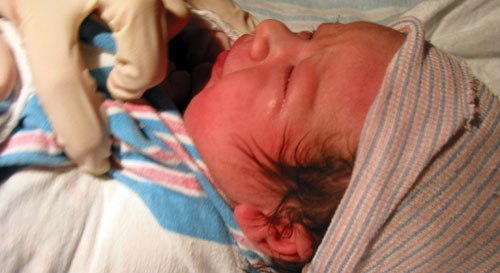Cerebral Palsy
Types of Cerebral Palsy Classified by Movement Disorder
Athetoid Cerebral Palsy

Athetosis
Athetosis is defined as follows:
The American Heritage® Stedman's Medical Dictionary
Athetosis is a constant succession of slow, writhing, involuntary movements of flexion, extension, pronation, and supination of fingers and hands, and sometimes of toes and feet.
Merriam-Webster Medical Dictionary
Athetosis is a nervous disorder that is marked by continual slow movements especially of the extremities and is usually due to a brain lesion.
[Back to Top]
Medical Malpractice during Labor and Delivery, or Shortlr Birth
Cerebral Palsy
Types of Cerebral Palsy Classified by Movement Disorder
Athetoid Cerebral Palsy
What is Athetoid Cerebral Palsy?
Athetoid Cerebral Palsy, also known as Dyskinetic Cerebral Palsy, is a type of Cerebral Palsy in which the permanent brain damage suffered during delivery, the permanent brain damage suffered at birth, or the permanent brain damage suffered shortly after birth causes coordination problems and problems controlling movements. People who suffer Athetoid Cerebral Palsy often move uncontrollably with a twisting or contorted motion; sometimes slow and writhing and sometimes fast and jerky.
The permanent brain damage that results in Athetoid Cerebral Palsy causes people who suffer Athetoid Cerebral Palsy to move constantly. The involuntary movements caused by Athetoid Cerebral Palsy commonly affect the hands, feet, arms, and legs.
In some cases, the permanent brain damage that results in Athetoid Cerebral Palsy affect the muscles of the face and tongue, which can cause involuntary sharp contortions of the face, difficulty sucking, swallowing, and speaking (a condition known as “dysarthria”), and uncontrollable drooling.
The involuntary movements characteristic of Athetoid Cerebral Palsy often become more severe during periods of emotional excitement and stress, and can disappear completely during sleep. Athetoid Cerebral Palsy
It is estimated that only about 10%-20% of the cases of Cerebral Palsy occurring today are cases of Athetoid Cerebral Palsy.
[Back to Top]
Types of Medic MalpracticeMedical Malelivery, or Shortly after Birth
Cerebral Palsy
Types of Cerebral Palsy Classified by Movement Disorder
Athetoid Cerebral Palsy
What Causes Athetoid Cerebral Palsy?
Athetoid Cerebral Palsy results from brain damage to the basal ganglia of the brain. The medical term "basal ganglia" refers to the large masses of gray matter at the base of the brain which control the ability to control movement.
[Back to Top]
Athetoid Cerebral Palsy
What Causes Athetoid Cerebral Palsy?
Severe Newborn Jaundice
Jaundice is yellowing of the skin, the whites of the eyes, and of mucous membranes caused by the build-up of bile salts in these tissues and a pigment called bilirubin in the blood. Jaundice can become severe. When Severe Newborn Jaundice is allowed to progress untreated due to Medical Malpractice / Professional Negligence / Delivery Malpractice, it can can result in the infant suffering Kernicterus, a type of permanent brain damage caused by high levels of bilirubin in the blood. The permanent brain damage caused by undiagnosed and untreated Severe Newborn Jaundice may result in the infant suffering Athetoid Cerebral Palsy.
Proper medical care in diagnosing and treating Severe Newborn Jaundice to prevent Kernicterus is critical. The failure to make a proper diagnosis of Severe Newborn Jaundice and/or the failure to provide proper treatment for Severe Newborn Jaundice may constitute Medical Malpractice / Professional Negligence / Delivery Malpractice. Without proper diagnosis and treatment, Severe Newborn Jaundice can cause permanent brain damage resulting in the infant suffering Athetoid Cerebral Palsy.
Again, the failure to make a proper diagnosis of Severe Newborn Jaundice and/or the failure to provide proper treatment for Severe Newborn Jaundice may constitute Medical Malpractice / Professional Negligence / Delivery Malpractice.
[Back to Top]
Athetoid Cerebral Palsy
What Causes Athetoid Cerebral Palsy?
Blood Type Incompatibility-Rh Disease
Blood Type Incompatibility between the mother and baby can cause Athetoid Cerebral Palsy. Rh Disease characterized by an incompatibility between the blood of the mother and her fetus. The blood type incompatibility can cause severe jaundice and brain damage, resulting in Athetoid Cerebral Palsy. Rh disease usually can be prevented by giving an Rh-negative woman an injection of a blood product called Rh immune globulin around the 28th week of pregnancy and again after the birth of an Rh-positive baby. The failure of a doctor to test for and properly treat Rh Disease may constitute Medical Malpractice / Professional Negligence / Delivery Malpractice and be the grounds for a lawsuit for Medical Malpractice / Professional Negligence / Delivery Malpractice.
[Back to Top]
Types of Medical MalpracticeMedical Malpractice during Labor and Delivery, rth
Cerebral Palsy
Types of Cerebral Palsy Classified by Movement Disorder
Athetoid Cerebral Palsy
Is Athetoid Cerebral Palsy Preventable?
Yes. There are effective treatments available to control bilirubin levels in the blood of a newborn baby. Because effective treatments are available, no newborn baby today should be allowed to develop Kernicterus and resultant Athetoid Cerebral Palsy, hearing loss, problems with vision and teeth, and, sometimes, mental retardation. With careful and proper medical care and treatment during delivery, at birth, and shortly after birth, Kernicterus is totally preventable. Because Athetoid Cerebral Palsy is preventable, the failure to make a proper diagnosis of Severe Newborn Jaundice and/or the failure to provide proper treatment for Severe Newborn Jaundice may constitute Medical Malpractice / Professional Negligence / Delivery Malpractice. If your child suffers from Athetoid Cerebral Palsy or any other disorder caused by Kernicterus, contact us now for help.
[Back to Top]
Where may we take you?
To learn about Birth Injuries and Delivery Malpractice, Click Here.
To learn more about Cerebral Palsy, Click Here.
To fill out our Free Online Questionnaire, Click Here.
To return the the Hurt by a Doctor homepage, Click Here.


